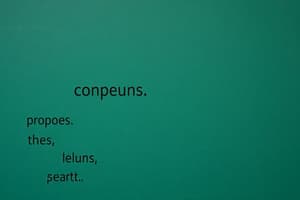Podcast
Questions and Answers
Which sentence demonstrates the correct use of a comparative adjective?
Which sentence demonstrates the correct use of a comparative adjective?
- Among all the paintings, this one is the most beautifuler.
- He is the more intelligent student in the class.
- She felt happier after receiving the good news. (correct)
- This cake is more tastier than the last one we baked.
In the sentence, 'The book on the table is mine,' what is the function of the prepositional phrase 'on the table'?
In the sentence, 'The book on the table is mine,' what is the function of the prepositional phrase 'on the table'?
- It acts as an adverb, modifying 'is'.
- It acts as a pronoun, replacing the noun 'table'.
- It acts as an adjective, describing 'book'. (correct)
- It acts as a conjunction, connecting 'book' and 'mine'.
Which of the following sentences correctly uses a demonstrative adjective?
Which of the following sentences correctly uses a demonstrative adjective?
- Those are her’s keys.
- I want that book over there.
- Theirs is a big family.
- The cat sat on that mat. (correct)
Select the sentence where the underlined word is a pronoun: She went to the store, and Mary purchased groceries.
Select the sentence where the underlined word is a pronoun: She went to the store, and Mary purchased groceries.
In which sentence does a conjunction effectively combine two independent clauses?
In which sentence does a conjunction effectively combine two independent clauses?
Flashcards
Pronoun
Pronoun
A word that replaces a noun, often to avoid repetition.
Proper Adjective
Proper Adjective
An adjective derived from a proper noun, always capitalized.
Demonstrative Adjective
Demonstrative Adjective
An adjective that points to a specific person or thing.
Comparative Adjective
Comparative Adjective
Signup and view all the flashcards
Prepositional Phrase
Prepositional Phrase
Signup and view all the flashcards
Study Notes
Pronouns
- Pronouns are used instead of nouns to refer to people or things previously mentioned.
- Examples: it, she, something, myself.
Proper Adjectives
- Formed from proper nouns.
- Always capitalized.
Demonstrative Adjectives
- Point out specific people or things.
- Examples: this, that.
Comparative Adjectives
- Used to compare two people or things.
- Typically end with "er".
Prepositional Phrases
- Can describe nouns or verbs.
- As adjectives, describe which one, what kind, or how many.
- As adverbs, indicate how, where, or when.
Conjunctions
- Combine sentences.
- Often use coordinating conjunctions (FANBOYS).
Studying That Suits You
Use AI to generate personalized quizzes and flashcards to suit your learning preferences.
Description
This lesson covers pronouns, proper and demonstrative adjectives, prepositional phrases and conjunctions. Pronouns replace previously mentioned nouns. Adjectives describe nouns, with proper adjectives formed from proper nouns. Conjunctions combine sentences.




